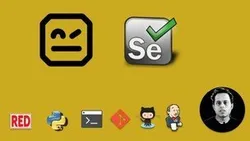
Software Analysis & Testing 
This course provides an in-depth exploration of software analysis and testing, including the theory and practice of diagnosing bugs, testing, and debugging. Students will gain a comprehensive understanding of the software development process. ▼
ADVERTISEMENT
Course Feature
![]() Cost:
Cost:
Free
![]() Provider:
Provider:
Udacity
![]() Certificate:
Certificate:
No Information
![]() Language:
Language:
English
![]() Start Date:
Start Date:
Self Paced
Course Overview
❗The content presented here is sourced directly from Udacity platform. For comprehensive course details, including enrollment information, simply click on the 'Go to class' link on our website.
Updated in [March 06th, 2023]
This course provides an overview of software analysis and testing. It covers the theory and practice of software analysis, which is essential for software development processes such as diagnosing bugs, testing, debugging, and more. Students will learn diverse techniques, each with their own strengths and limitations, for automating tasks such as testing, debugging, and finding bugs in complex real-world programs. These techniques include dataflow analysis, constraint-based analysis, type systems, model checking, symbolic execution, and more. The course will teach the principles underlying these techniques as well as provide hands-on experience with using and implementing tools based on these techniques.
[Applications]
The application of this course can be seen in the development of software systems. Students can use the techniques learned in this course to develop automated tools for testing, debugging, and finding bugs in complex real-world programs. Additionally, the principles and techniques learned in this course can be used to develop more efficient and reliable software systems. Furthermore, the knowledge gained from this course can be used to develop better software engineering practices and processes.
[Career Paths]
Career Paths:
1. Software Quality Assurance Engineer: Software Quality Assurance Engineers are responsible for ensuring that software meets the highest standards of quality and reliability. They use a variety of tools and techniques to test software, identify bugs, and ensure that the software meets the requirements of the customer. This role is expected to grow as software becomes increasingly complex and companies strive to ensure the highest quality of their products.
2. Software Test Automation Engineer: Software Test Automation Engineers are responsible for developing and maintaining automated tests for software applications. They use a variety of tools and techniques to create automated tests that can be used to quickly and accurately test software applications. This role is expected to grow as companies strive to reduce the time and cost associated with manual testing.
3. Software Security Analyst: Software Security Analysts are responsible for ensuring that software applications are secure and free from vulnerabilities. They use a variety of tools and techniques to identify and address security issues in software applications. This role is expected to grow as companies strive to protect their applications from malicious attacks.
4. Software Performance Engineer: Software Performance Engineers are responsible for ensuring that software applications perform optimally. They use a variety of tools and techniques to identify and address performance issues in software applications. This role is expected to grow as companies strive to ensure that their applications are able to handle increasing amounts of data and traffic.
[Education Paths]
1. Bachelor of Science in Computer Science: This degree program provides students with a comprehensive understanding of computer science fundamentals, including programming, software engineering, computer architecture, and operating systems. Students will also learn about the latest trends in software analysis and testing, such as machine learning, artificial intelligence, and data science.
2. Master of Science in Software Engineering: This degree program focuses on the development of software systems, including software analysis and testing. Students will learn about the principles of software engineering, such as software design, software architecture, software testing, and software quality assurance. They will also gain experience in developing and testing software systems using the latest tools and technologies.
3. Doctor of Philosophy in Computer Science: This degree program provides students with an in-depth understanding of computer science, including software analysis and testing. Students will learn about the principles of software engineering, software design, software architecture, software testing, and software quality assurance. They will also gain experience in developing and testing software systems using the latest tools and technologies.
4. Master of Science in Artificial Intelligence: This degree program focuses on the development of artificial intelligence systems, including software analysis and testing. Students will learn about the principles of artificial intelligence, such as machine learning, natural language processing, and computer vision. They will also gain experience in developing and testing AI systems using the latest tools and technologies.
Course Provider

Provider Udacity's Stats at AZClass
Discussion and Reviews
0.0 (Based on 0 reviews)
Explore Similar Online Courses

Chair Yoga for Seniors & Beginners

FREE JavaScript for Beginners & Professionals 2022

Python for Informatics: Exploring Information

Social Network Analysis

Introduction to Systematic Review and Meta-Analysis

The Analytics Edge

DCO042 - Python For Informatics

Causal Diagrams: Draw Your Assumptions Before Your Conclusions

Whole genome sequencing of bacterial genomes - tools and applications

Boost Your Game Performance in Unity 3D

ISTQB Certified Tester Foundation Level Training (CTFL)


Start your review of Software Analysis & Testing